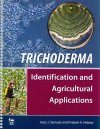About this book
This is the 'how to' book for Trichoderma, a genus of ecologically important beneficial microorganisms that has been shown to be useful in meeting critical agricultural challenges such as nutrient and mineral uptake and remediation of toxic elements. Expertly written, the authors of Trichoderma: Identification and Agricultural Applications draw on and translate the experimental literature to explain how to isolate cultures of Trichoderma and how to select, handle, formulate, identify, and register effective strains of Trichoderma species. They clearly describe the process of identifying Trichoderma cultures to species using molecular and classical techniques. Descriptions and illustrations of forty-five species are provided along with a key for their identification and illustrations for each.
Trichoderma: Identification and Agricultural Applications provides details of isolating Trichoderma, selecting efficacious cultures, maintaining cultures, formulating Trichoderma for application, and applying Trichoderma. This is the first time that such a large number of Trichoderma species has been included in a key. No single source provides so much highly detailed information for identifying Trichoderma and for selecting and applying the selected strains in agriculture. The growing market for organically produced food, combined with an increasing awareness of some of the undesirable effects of chemically based disease control and fertilization demand alternative methods of crop management. Trichoderma is recognized for its potential to reduce use of these chemicals and can be part of an integrated crop management program that leads to certification of an organic agricultural product. This book guides the reader into the use of Trichoderma.
A special section of Trichoderma: Identification and Agricultural Applications titled, "Interactions Among Trichoderma Species, Plants, and Their Pathogens: A Primer," summarizes much of the genomic interaction knowledge from a layman's point of view. This section is important for agriculturalists who want to understand how this beneficial microorganism interacts with the plant and the pathogens. Through this understanding, new applications and advances in crop management techniques will be possible.
This spiral-bound laboratory manual provides plant pathologists, biocontrol researchers, diagnosticians, ecologists, mycologists, and even medical/veterinary diagnosticians with a useful resource for identifying Trichoderma and utilizing Trichoderma attributes in agricultural applications and studies.
Contents
Chapter 1: Introduction
- Introduction to the Genus Trichoderma
- Biogeography and Host Specificity
Chapter 2: Developing Trichoderma-Based Products for Application in Agriculture
- Interactions Among Trichoderma Species, Plants, and Their Pathogens: A Primer
- Applying Trichoderma Species in Agriculture
- Identify the Problem: Understand the Crop and the Target
- Find the Right Culture
- Isolating Trichoderma species
- Assay for Biological Activity
- Considerations in plant bioassays
- Assays for mycoparasitism
- In planta assays for beneficial effect
- Identify the Mode of Action and Ecology
- Determine Methods of Formulation and Shelf Life Studies
- Selecting a fermentation (liquid, solid-state) method
- Preserve Cultures
- Register Product
- Concluding Remarks
Chapter 3: Applications of Trichoderma Species in the Field and Greenhouse
- A Few Comments on Testing
- Soil Application of Trichoderma Cultures
- Suppressive Soils and Composts
- The Use of Trichoderma Species in Soilless and Hydroponic Systems
- Seed Treatments
- Applying Trichoderma Conidia to Seeds
- Topical Applications
- Using Trichoderma Species to Enhance Plants Developed by Tissue Culture
Chapter 4: Systematics of the Genus Trichoderma
- Trichoderma vs. Gliocladium
- Are There Biocontrol Species of Trichoderma?
- Identification of Trichoderma Species
- Identification of Trichoderma Species Using DNA Sequences
- Identification of Trichoderma Species Using Chemical Methods
- Biolog FF MicroPlates
- MALDI-TOF mass spectrometry
- Identification of Trichoderma Species Using Cultures and Morphology
- Media and incubation
- Macroscopic characters: Characters observed in the petri plate directly or with use of a stereomicroscope
- Micromorphology: Characters observed using a compound microscope
Chapter 5: Synoptic Key to Forty-Five Trichoderma Species
- Using the Key
- Synoptic Key
- Trichoderma Species Included in the Synoptic Key
Chapter 6: Trichoderma Species Descriptions
- Trichoderma aggressivum
- Trichoderma amazonicum
- Trichoderma asperellum
- Trichoderma atroviride
- Trichoderma aureoviride
- Trichoderma brevicompactum
- Trichoderma capillare
- Trichoderma citrinoviride
- Trichoderma crassum
- Trichoderma deliquescens
- Trichoderma effusum
- Trichoderma erinaceus
- Trichoderma evansii
- Trichoderma flagellatum
- Trichoderma gamsii
- Trichoderma ghanense
- Trichoderma hamatum
- Trichoderma harzianum
- Trichoderma koningii
- Trichoderma koningiopsis
- Trichoderma lieckfeldtiae
- Trichoderma longibrachiatum
- Trichoderma longipile
- Trichoderma minutisporum
- Trichoderma orientale
- Trichoderma ovalisporum
- Trichoderma paucisporum
- Trichoderma pleuroti
- Trichoderma pleuroticola
- Trichoderma polysporum
- Trichoderma pseudokoningii
- Trichoderma pubescens
- Trichoderma reesei
- Trichoderma rossicum
- Trichoderma saturnisporopsis
- Trichoderma saturnisporum
- Trichoderma spirale
- Trichoderma stilbohypoxyli
- Trichoderma strigosum
- Trichoderma stromaticum
- Trichoderma tomentosum
- Trichoderma velutinum
- Trichoderma virens
- Trichoderma viride
- Trichoderma viridescens
Literature Cited
Index
Customer Reviews































![Nuevo Diccionario Ilustrado de Micologia [New Illustrated Dictionary of Mycology]](http://mediacdn.nhbs.com/jackets/jackets_resizer_medium/15/157811.jpg?height=150&width=113)







